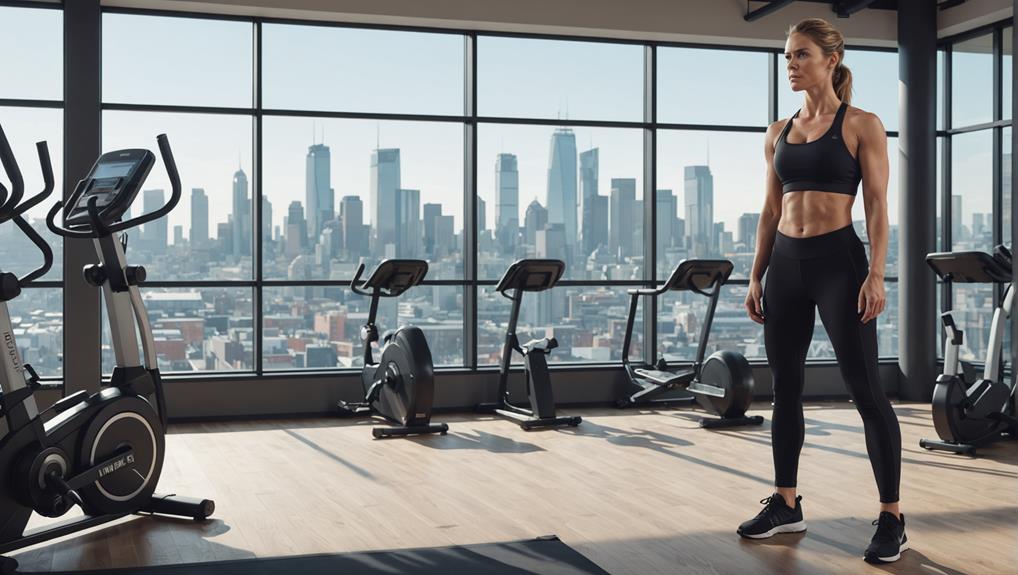If you're looking for a canine companion that thrives on daily walks, playtime, and mental stimulation, but doesn't require extreme exercise, medium-energy breeds are ideal for you. Breeds like Cavalier King Charles Spaniels and Golden Retrievers offer a perfect mix of energy and adaptability. They enjoy physical activity, multiple walks a day, and interactive play sessions, making them perfect for semi-active owners. With regular exercise, mental stimulation, and positive training, these breeds provide balanced companionship. By understanding their exercise needs and tailoring your routine to their energy levels, you'll find a harmonious match. Dive deeper to discover more about these breeds and how to create a fulfilling relationship.
Key Takeaways
- Medium-energy breeds like Cavalier King Charles Spaniels and Golden Retrievers are ideal for semi-active lifestyles, thriving on daily walks and playtime.
- Regular exercise, mental stimulation, and positive training are essential for medium-energy breeds to prevent restlessness and destructive behavior.
- A balanced diet meeting macronutrient requirements supports joint health, heart function, and overall well-being in medium-energy dogs.
- Assessing your living situation, daily routine, and family dynamics helps choose a breed that aligns with your lifestyle and provides companionship.
- Socialization and training create a strong bond between you and your dog, instilling good behavior, obedience, and communication in a semi-active lifestyle.
Semi-Active Lifestyle Companions
If you're looking for a furry companion to match your semi-active lifestyle, medium-energy dog breeds are the perfect fit. These breeds enjoy moderate exercise and play, but don't require high-intensity activities all the time. They're ideal for individuals who want a balanced companionship without feeling overwhelmed by demanding exercise routines. Medium-energy dog breeds thrive on daily walks, playtime, and mental stimulation, making them a great match for semi-active owners.
As a semi-active individual, you'll appreciate the flexibility that medium-energy breeds offer. They'll happily accompany you on leisurely strolls or shorter, more energetic walks. They'll also enjoy playtime, but they won't demand hours of intense physical activity. Mental stimulation, such as training sessions or puzzle toys, will also keep them engaged and happy.
Characteristics of Medium-Energy Breeds

When it comes to understanding the perfect companions for your semi-active lifestyle, recognizing the characteristics of medium-energy breeds is crucial. These breeds are designed for you, striking a balance between an adventurous spirit and the ability to relax.
As a semi-active individual, you'll appreciate that medium-energy dogs enjoy physical activity and multiple walks a day to maintain their health and well-being. They're adaptable to various living arrangements, thriving in both urban and rural environments.
To guarantee your medium-energy dog remains happy and well-adjusted, they require regular exercise, mental stimulation, and positive training. This balanced approach will bring out the best in your pet, showcasing their versatility and engaging nature.
From playful moments to calm relaxation, medium-energy breeds like Cavalier King Charles Spaniels and Golden Retrievers offer the perfect mix. By understanding these characteristics, you'll be better equipped to provide the ideal environment for your new companion, fostering a strong and loving bond.
Exercise Needs and Routines

You'll need to commit to a regular exercise routine to keep your medium-energy dog happy, healthy, and entertained. As a semi-active dog owner, it's important to provide your dog with structured exercise routines that cater to their moderate energy levels. Daily walks and playtime are a must to prevent boredom and promote physical fitness. Tailoring exercise activities to match your dog's energy level will guarantee they receive the right amount of stimulation.
Interactive play sessions and mental stimulation activities are also vital to keep your semi-active dog engaged and happy. Consistency is key, so establish a routine that works for you and your dog. Aim for a balance of physical and mental exercise to prevent weight gain and promote overall wellness. By doing so, you'll be rewarded with a balanced companion that thrives on their semi-active lifestyle.
Training for Balanced Behavior

As you bring a semi-active dog into your lifestyle, you'll want to focus on training methods that promote balanced behavior.
Consistent training routines and positive reinforcement techniques are key to shaping your dog's behavior and establishing clear expectations.
Consistent Training Methods
By incorporating consistent training methods into your daily routine, you'll be able to establish a strong foundation for balanced behavior in your dog. This is vital for a semi-active lifestyle, where your dog needs to be well-behaved and adaptable.
Consistency in training builds trust and strengthens the bond between you and your dog, leading to a happier and more well-adjusted companion.
To achieve balanced behavior, focus on the following key elements:
- Positive Reinforcement: Reward good behavior with treats, praise, and affection to encourage positive habits.
- Routines and Boundaries: Establish clear rules and routines to provide a sense of structure and stability for your dog.
- Regular Training Sessions: Set aside time each day for training and exercise to reinforce good behavior and prevent bad habits from forming.
Positive Reinforcement Techniques
Positive reinforcement techniques are a powerful tool in your training arsenal, allowing you to encourage good behavior in your dog by rewarding desired actions with treats, praise, and affection. This approach focuses on building a strong bond between you and your dog, fostering a sense of trust and respect.
By consistently rewarding desired behaviors, you're encouraging their repetition, making it a valuable method for teaching new commands and modifying unwanted behaviors. Treats, praise, and toys are all effective rewards that can be used to motivate your dog.
When using positive reinforcement training, it's essential to be patient and consistent, as this will help your dog understand what behavior is being rewarded. With time and practice, you'll be able to develop a well-behaved and balanced companion that thrives in a semi-active lifestyle.
Nutritional Considerations Explained

When considering the nutritional needs of your semi-active dog, understanding the importance of a balanced diet that meets their macronutrient requirements is crucial.
Since medium-energy breeds don't require extreme levels of protein or fat, you'll want to focus on finding a diet that provides the right amount of calories and nutrients to support their moderate activity level.
Balanced Diets for Medium-Energy
When it comes to fuelling your medium-energy dog's lifestyle, a balanced diet that meets their unique nutritional needs is essential for maintaining their overall health and energy levels. As a responsible dog owner, it's important to provide your furry friend with a diet that caters to their medium-energy requirements.
Here are three key components to look for in a balanced diet for your medium-energy dog:
- Essential nutrients: Glucosamine, Chondroitin, Taurine, and omega fatty acids are important for supporting joint health, heart function, and overall well-being.
- Balanced macronutrients: A mix of proteins, fats, and carbohydrates provides the energy your dog needs to stay active and healthy.
- High-quality ingredients: Look for dog foods with high-quality protein sources, whole grains, and healthy fats to make sure your dog is getting the nutrients they need.
Macronutrient Needs Explained
You'll need to tailor your dog's macronutrient intake to their specific energy level, whether that means fuelling high-intensity activities or supporting a more relaxed pace.
As a semi-active dog owner, understanding macronutrient needs is essential to supporting your dog's overall health. High-energy dog breeds, such as Border Collies and Australian Shepherds, require diets rich in high-quality proteins and fats to sustain their active lifestyle. On the other hand, low-energy breeds, like Bulldogs and Pugs, benefit from diets lower in calories and fats to maintain a healthy weight.
Macronutrient needs vary based on the energy levels of dog breeds. High-energy breeds may need foods with higher calorie content, while low-energy breeds require portion control.
Nutritional considerations play an essential role in supporting the energy levels and overall health of different dog breeds. By understanding your dog's specific macronutrient needs, you can provide the necessary fuel for their active lifestyle, ensuring they stay healthy and happy.
Choosing the Right Dog Food

Your semi-active lifestyle demands a dog breed that's equally adaptable, and feeding them the right food is essential to support their energy needs and overall health. As a dog owner, it's important to take into account your dog's energy level when selecting the perfect food. High-energy breeds require higher-calorie content foods with quality proteins and fats to sustain their active lifestyle, while low-energy breeds benefit from diets lower in calories and fats to prevent weight gain and maintain overall health.
Here are three key considerations when choosing the right dog food:
- Energy level: Match your dog's energy level with the right calorie content to make sure they're fueled for their active lifestyle.
- Nutritional needs: Consider essential nutrients like glucosamine, chondroitin, taurine, and omega fatty acids to support joint health and overall well-being.
- Consult your vet: Determine the best feeding schedule, portion sizes, and specific dietary requirements based on your dog's energy level and health status with the help of your veterinarian.
Assessing Your Lifestyle Needs

When starting your search for the perfect canine companion, it's crucial to take a step back and assess your lifestyle needs.
You'll want to evaluate your daily routine, living situation, and family dynamics to determine the level of activity and companionship your ideal dog breed should provide.
Assessing Living Situation
When evaluating your living situation, it's important to keep in mind the physical space available, as a semi-active dog breed's exercise needs must align with your available room for activity. A spacious home or a cozy apartment can greatly impact the suitability of a dog breed.
For instance, a larger living area can accommodate a dog that requires more exercise, while a smaller space may be better suited for a breed that's content with shorter, more gentle activities.
Keep in mind the following factors when appraising your living situation:
- Space for exercise: Can your living area accommodate a dog that needs regular exercise, or would a breed with lower exercise needs be a better fit?
- Storage and safety: Do you have enough space to store dog supplies, and are there any safety concerns, such as hazardous materials or fragile items, that need to be taken into account?
- Noise level: If you live in an apartment or shared living space, you may need to think about a breed that's quieter or less prone to barking.
Daily Routine Evaluation
Before bringing a dog into your life, you need to take a hard look at your daily routine to determine how much time and energy you can realistically devote to a furry friend. This daily routine evaluation is vital in gauging your lifestyle needs and ensuring you can provide the necessary care and attention for a dog.
Consider your work schedule, family commitments, and social activities when evaluating your daily routine. Ask yourself if you have time for daily walks, playtime, and mental stimulation for a dog.
Can you dedicate a few hours each day to interact with your dog, or will your busy schedule leave them feeling lonely and neglected? Be honest about your ability to provide companionship, training, and attention to a dog based on your lifestyle.
Family Dynamics Analysis
Now that you've assessed your daily routine, it's time to evaluate your family dynamics to ensure a dog fits comfortably into your lifestyle. This involves examining the number of family members, their ages, and activity levels.
For instance, if you have young children, you'll want a breed that's gentle and patient. On the other hand, if you have teenagers, you may want a breed that's more energetic and can keep up with their active lifestyle.
Here are three key factors to ponder when analyzing your family dynamics:
- Family size and ages: How many people live in your household, and what're their ages? This will help you determine the ideal breed size and energy level.
- Activity levels: Are your family members generally active or sedentary? This will impact the amount of exercise and stimulation your dog needs.
- Dynamics and preferences: What're the personalities and preferences of your family members? Do they want a small, low-maintenance dog or a larger, more energetic breed?
Importance of Socialization and Training

Your dog's ability to thrive in a semi-active lifestyle largely depends on the foundation you lay through proper socialization and training.
Socialization is critical in helping your dog adapt to various environments, people, and animals, reducing fear, aggression, and anxiety. This, in turn, enables them to develop good behavior, obedience, and effective communication with you.
Training takes it a step further by instilling good behavior, obedience, and communication, creating a strong bond between you and your dog. It also provides mental stimulation, engagement, and a sense of accomplishment, which are essential for a happy and well-behaved dog.
By investing time and effort in socialization and training, you'll reap the rewards of a well-rounded, happy, and well-behaved companion that thrives in a semi-active lifestyle.
A strong foundation in socialization and training sets the stage for a lifelong journey of growth, learning, and enjoyment with your dog.
Adapting to Mismatched Energy Levels

Adapting to mismatched energy levels between you and your dog is crucial in a semi-active lifestyle. This adjustment is necessary to cater to your dog's energy requirements, as failing to do so can lead to frustration and guilt.
Mismatched energy levels can pose a challenge in meeting your dog's exercise and mental stimulation needs, potentially resulting in restlessness and destructive behavior. To bridge this gap, it's vital to modify your routine and activities accordingly.
Here are some ways to adapt:
- Employ dog walkers or engage in interactive play sessions to provide your dog with the physical activity they need.
- Provide puzzle toys that challenge your dog's mind and keep them engaged for extended periods.
- Understand your dog's breed characteristics and energy level to tailor your approach to their specific needs.
Finding Your Perfect Canine Match

When selecting a breed, consider medium-energy dog breeds that balance exercise needs with a desire for companionship, making them an ideal fit for a semi-active lifestyle.
You'll want to find a breed that matches your energy levels, ensuring a harmonious bond between you and your dog.
Medium-energy breeds like Cavalier King Charles Spaniels and Golden Retrievers offer a balanced companionship, requiring moderate exercise and playtime.
If you're looking for breeds that adapt well to varying activity levels, consider Vizslas or Border Collies. They'll thrive with moderate exercise and mental stimulation, making them a great fit for your semi-active lifestyle.
By choosing a breed that fits your lifestyle and energy level, you'll create a perfect canine match.
Remember, it's essential to match your exercise needs with your dog's, ensuring you both get the physical and mental stimulation you need.
With the right breed, you'll enjoy a balanced companionship that brings joy and fulfillment to your life.
Frequently Asked Questions
What Breed of Dog Is Best for Companionship?
When seeking a breed for companionship, you'll find that Cavalier King Charles Spaniels, Golden Retrievers, Pugs, Australian Shepherds, and Boxers excel as loving friends, offering affection, loyalty, and adaptability to fit your lifestyle.
What Is a Mid-Energy Level Dog?
".credentials in check, you're asking the right question As you ponder, a mid-energy level dog is one that needs regular exercise and mental stimulation, but isn't a hyperactive handful, striking a perfect balance for your semi-active lifestyle."
What Is the Best Dog for an Inactive Person?
"If you're an inactive person, a low-energy dog breed like a Basset Hound, Shih Tzu, or French Bulldog is perfect for you, requiring only leisurely walks and shorter play sessions."
What Is the Best Dog for Protection and Companionship?
If you're looking for a dog that's both protective and loving, consider breeds like Belgian Malinois, German Shepherds, Rottweilers, or Doberman Pinschers – they'll keep you safe while showering you with affection.
Conclusion
You've found your perfect canine companion – a breed that fits your semi-active lifestyle. Now, it's time to begin a journey of love, care, and adventure together.
Will you be able to provide the exercise, training, and socialization your dog needs to thrive? With the right breed and your commitment, the answer is a resounding 'yes!'
Get ready to enjoy a lifetime of balanced companionship and create unforgettable memories with your new furry friend.








